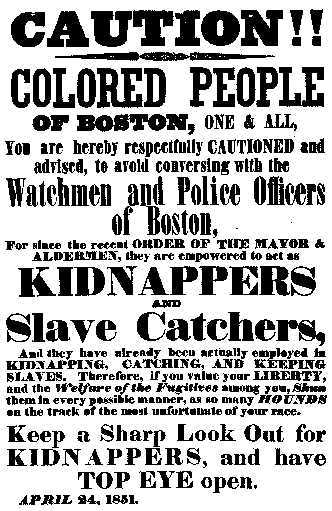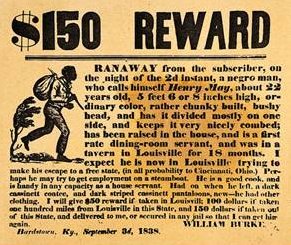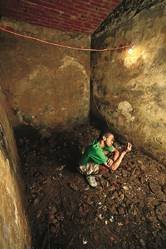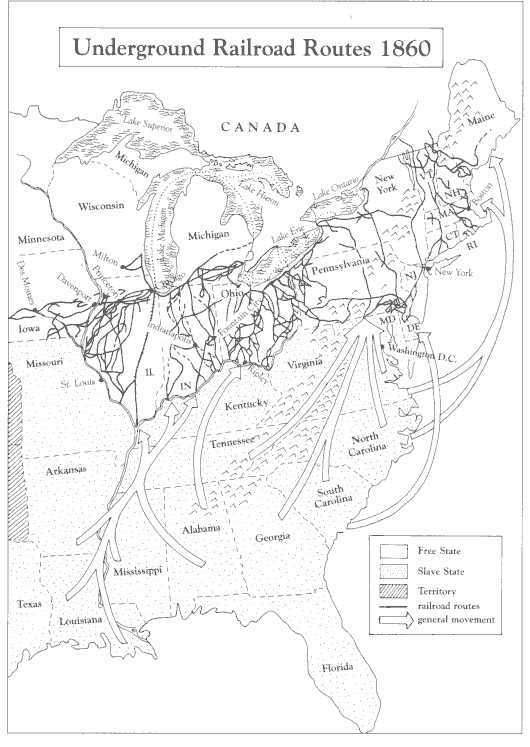The Fugitive Slave Act
by Blythe Nelson
The Fugitive Slave Act was actually a series of laws that stipulated that it was illegal for any citizen to assist an escaped slave on the road to freedom. This act demanded that if an escaped slave was sighted, that he or she should be apprehended and turned into the authorities for deportation back to the "rightful" owner down south.
This law gave slave owners the right to organize a posse at any point in the United States to aid in the recapture of a runaway slave. Courts and police everywhere were obligated to assist them. Private citizens were also obligated to recapture the runaways. People who were caught helping slaves received jail time and had to pay fines and restitution to the slave owner.
 Poster Warning Escaped Slaves to avoid Police |
Abolitionists put up signs such as these to warn slaves of the dangers of being caught and put back into slavery. At first authorities thought that the Fugitive Slave Act would diminish the number of slaves wanting to run away, somehow that the threat of being returned back to their owners after a slave had escaped his or her plantation, would be enough to deter a slave from escaping.
 Escaped Slave Reward Poster |
Rewards were often offered for the safe return of a valued slave. Some slaves had been bought for higher prices than that of their rewards.
No one knows exactly when the Underground Railroad was started. There were isolated accounts of citizens helping slaves on their way to freedom as far back as the 1700s. By the early 19th century, after the Fugitive Slave act had passed, there were more organized flights to freedom.
The Underground Railroad was neither "underground" nor a "railroad," it was however a loose network of aid and assistance for the slaves to help them escape from a life of bondage. Perhaps as many as one hundred thousand enslaved men, women and children escaped by way of the Underground Railroad.
Charles H. Blockson describes the Underground Railway in National Geographic as "...a network of paths through the woods and fields, (using) river crossings, boats and ships, trains and wagons, all haunted by the specter of recapture." Courageous men and women who believed in the right of all humans to be free from human bondage made the slaves' flight to freedom possible.
 American Anti-slavery Almanac |
Often runaways escaped in small groups, but sometimes alone. African American and white "conductors" risked their lives and property to escort refugees to freedom. Most slaves traveled at night, using darkness to avoid being easily recaptured. During the day slaves were harbored in hidden places and rooms, and sometimes these rooms measured only 12 feet by 15 feet, but gave shelter to up to 20 refugees.
 Hidden Room |
Hundreds of people were involved in the efforts of the Undergroung Railroad. Celebrated conductors of the Underground Railroad include James Fairfield; a white abolitionist who went into the south and rescued enslaved African Americans by posing as a slave trader. In 1849, Harriet Tubman escaped from Maryland and became known as "Moses," a nickname given to her when she made 19 trips to the South and helped at least 300 fellow captives to liberation. African American abolitionist John Parker frequently ventured to Kentucky and Virginia and helped transport hundreds of runaways by boat across the Ohio River to freedom.
Many other unknown people helped overturn the Fugitive Slave Act by supporting the Underground Railroad and it's efforts. If anything the Fugitive Slave Act heightened the amount of people helping runaway slaves, and the Underground Railroad provided those runaway slaves with a road to freedom.
 Underground Railway System of Escape Routes |
| sources: | Blockson, Charles H. "Escape from Slavery: The Underground Railroad."National Geographic Magazine. |
| "The Fugitive Slave Law" at: http://education.ucdavis.edu/NEW/STC/lesson/socstud/ SlaveLaw.htm |
|
| "Facts on the Underground Railroad" at: http://www.history.rochester.edu/class/ugrr/hor2.html | |
| photos: | "Slave room" at: http://www.smithsonianmag.si.edu/smithsonian/issues96/oct96/ inspects_jpeg.html |
| "Almanac" at: http://education.ucdavis.edu/NEW/STC/lesson/socstud/railroad/ images/chains.jpg |
|
| "Caution Slaves" at: http://education.ucdavis.edu/NEW/STC/lesson/socstud/railroad/ images/caution.jpg |
|
| "Underground introduction" at: http://www.nps.gov/undergroundrr/contents.htm | |
| "Routes of the Underground Railroad" at: http://education.ucdavis.edu/NEW/STC/lesson/socstud/railroad/map.htm |